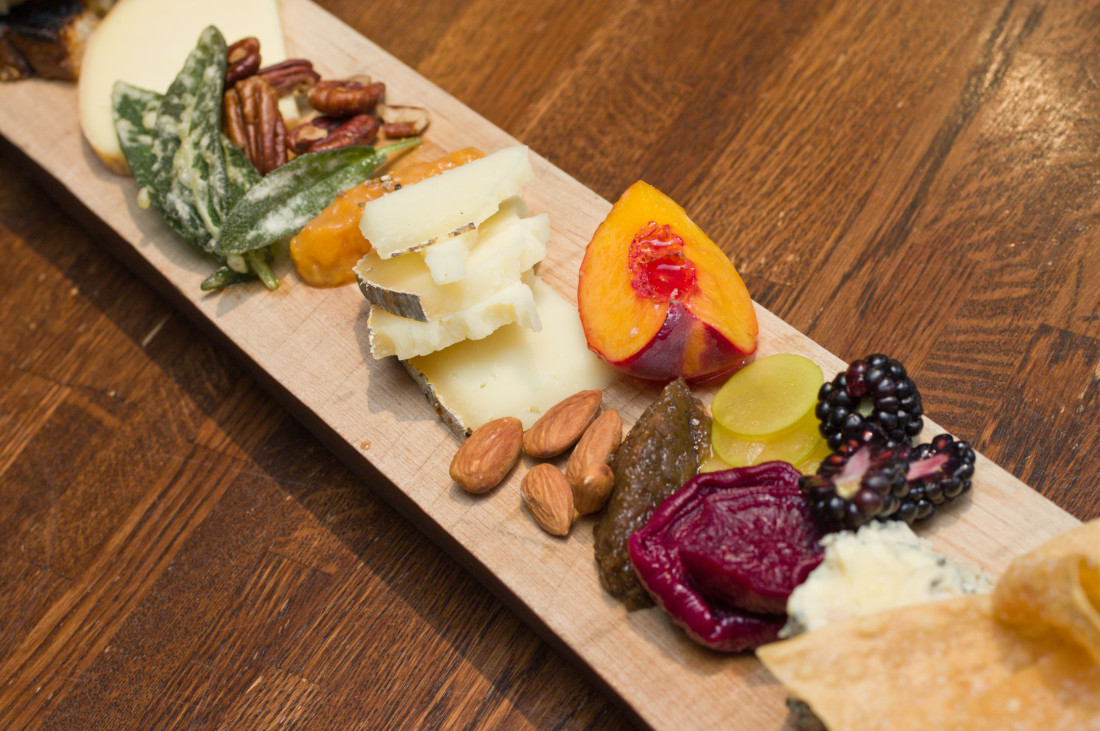Most upscale restaurants have them, as do many neighborhood pubs. They can serve as an appetizer, a dessert (if you want to eat like a European) or even as a meal unto themselves. Cheese plates are as adaptable and unique as the chefs and restaurants that prepare them, so Mountain Xpress recently undertook an exploration of Asheville’s cultured offerings.
Over the course of a month, WNC Cheese Trail executive director and Cheese Store of Asheville owner Katie Moore, her assistant Erin Dickinson and Bouchon manager and home cheesemaker Lindsey Menendez — all of whom are involved in the upcoming launch of the new Cheese Bar at 5 Walnut — joined Xpress for a marathon tour of the diverse cheese choices at downtown, River Arts District and West Asheville restaurants. While a variety of offerings was sampled, it wasn’t possible to visit every restaurant in the area. Also, as selections rotate regularly and with the seasons, the focus is not on specific brands, but on each venue’s unique approach to cheese presentation.
During the sampling, the group remained aware of these criteria:
1. Service: A knowledgable server who can tell you about everything on the plate and where it comes from is paramount.
2. Variety and compatibility: Do the flavors represented on the board line up? Do the cheeses have a variety of textures, aromas and sharpness? Do the pairings play well together and complement the work of the cheesemakers? Also, this group found it important that the pairings didn’t touch the cheese. The sad sight of a perfect chèvre drenched in honey highlights neither the honey nor the cheese. It’s preferable for the diners to do the drizzling themselves.
3. Presentation: This was a controversial point among members of the group. Some saw value in presentation but do not consider it to be imperative. Others, however, felt the attractiveness of the plate was paramount.
4. Ripeness and age: Serve a Brie before its time, and it lacks pizzaz. But keep it in the fridge too long, and it will be sour and taste ammoniated. Knowing when a cheese is ready is key.
Here are a few of the cheese plates the team experienced during the tour:
Cucina 24
Before diving into Cucina 24’s impeccably produced pastas and entrées, be sure to work your way across its cheese board — a long, sprawling plank of house-made pickles, ferments, breads, crackers and massive portions of locally made and imported cheeses. “I thought it was neat how they really stayed true to who they are as a restaurant,” says Menendez. Just like their cuisine overall, which is an Italian take on Appalachian ingredients, the board is a mix of local and imported cheeses beautifully displayed. Moore also observes that the servers at Cucina are knowledgable about the cheese-board offerings.
Rhubarb
A spread for the hardcore cheeseheads out there, Rhubarb’s cheese plate is simple and focused entirely on North Carolina cheeses with little to interfere. “The cheeses worked well together but were also all very different,” Moore says. And Menendez adds, “They gave us a lot of cheese, and then they gave us almonds, two types of jams, and the house-made bread. And that is how I want to eat a cheese plate.”
The Market Place
“Fancy” is how Dickinson describes The Market Place’s large wooden slabs artfully arranged with hefty cuts of cheeses from area artisans such as Cane Creek Creamery and Yellow Branch Farm. Nuts and foraged herbs and fruits like serviceberries round out the presentation. “This was one of few we had where the cheeses weren’t touched by something that would impart some other flavor,” Menendez says. “There were jams and things, but they were separated. They really left the cheese alone.”
The Bull and Beggar
The Bull and Beggar’s cheese board is a simple, elegant presentation of five cheeses ranging from creamy and spreadable to aged and aromatic. Each offering was individually paired with explosively flavorful house-made jam or chutney, fresh fruits or honey. “The presentation was beautiful, and all the cheeses were very, very good,” says Moore, who also observes that the entire board was carefully composed of imported varietals from France and Spain.
The Junction
The cheese platter at The Junction is filling enough to serve as a meal. “If I were going to go have a drink and something to eat, and that’s all I was going to do all night, this is the one I would get,” says Dickinson. The board is heavy with house-made charcuterie in addition to its cheeses.
Urban Orchard
Urban Orchard’s board is also substantial and offers a wide variety of entirely local cheeses, mostly from Looking Glass Farm and Three Graces Dairy, with unique fruit pairings such as kiwi and orange, along with almonds, olives and pickles. “For a neighborhood bar, you really wouldn’t expect something like that,” notes Dickinson. “It’s really nice,” Moore adds, “It’s really fun to pair with a cider instead of a wine or a beer.”
Chestnut
Chestnut presents a massive platter of excellent charcuterie and regional and imported cheeses. With its piles of greens, fruits and accoutrements, Menedez points out, “It really was like a picnic plate.” Moore says, “To me, if you wanted to go and have a cheese plate as your meal, that’s the way to do it.” It is decidedly more meat-heavy than cheesecentric, so it might not be the best option for the veg heads in your crew.




Posting time
Aug 5, 2016 AD.
Mmmm, that looks good.
That looks like what locals could afford if class warfare were acknowledged here.
To butcher Marie Antoinette,
“Let them eat cheese”.